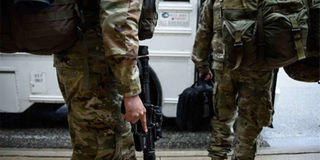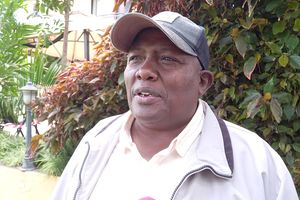Premium
US unlikely to meet schedule for 'degrading' Al Shabaab

US troops head out for a deployment on January 4, 2020 in Fort Bragg, North Carolina. A report by the US Defence Department has cast doubt on Africom's impact on degrading Al Shabaab outside of Mogadishu. PHOTO | FILE | GETTY IMAGES | AFP
What you need to know:
- “There was no significant progress” toward Africom's goal of creating “security cocoon around Mogadishu,” says the US Defence Department report covering the last three months of 2019.
- Shabaab retains resilience despite a concerted US airstrike campaign that included 63 strikes on militant-associated targets last year.
New York
The US Army's Africa Command (Africom) says in a new report that it aims to render al-Shabaab incapable of conducting effective operations by next year.
But the military situation in Somalia, as appraised by the US Defence Department's inspector general, makes it appear unlikely that this ambitious timetable will be met.
In its “campaign plan” outlined in the Defence Department study released on Tuesday, Africom asserts an objective of degrading Shabaab by no later than September 2021.
According to the Africa Command, that term means Shabaab will no longer be able to conduct large-scale attacks inside Somalia or in Kenya and other neighbouring countries.
The militant group that has been fighting since 2006 to oust foreign forces and establish a caliphate in Somalia would also be stripped of its ability to recruit personnel and to maintain safe havens, Africom adds.
The inspector general's assessment finds, however, that in recent months “there was limited impact on degrading Al Shabaab outside of Mogadishu.”
This was due, the study says, to slow police force generation and lack of stabilisation activities, including local governance, within seized towns in the Lower Shabelle region.
In addition, “there was no significant progress” toward Africom's goal of creating a security cocoon around Mogadishu, says the report covering the last three months of 2019.
A US military intelligence assessment cited in the new report concludes that Shabaab continues to pose a high threat against the Somali government forces, the African Union Mission in Somalia (Amisom) and key infrastructure in the country.
RESILIENT
Shabaab retains that capability despite a concerted US airstrike campaign that included 63 strikes on militant-associated targets last year.
Two weeks ago, Gen Stephen Townsend, head of the Africa Command, told the US Senate that of all the violent extremist groups active in Africa, “al-Shabaab is the most dangerous to US interests today.”
The general's remarks followed an attack on the Manda Bay Kenya-US military installation in Lamu that killed three Americans and destroyed six aircraft.
The 76-page report by the Defence Department's inspector general covers the US military role in conflicts throughout the African continent.
WEST AFRICA
It is even more pessimistic about the situation in West Africa, where the growing strength of Islamist insurgents has led Africom to retreat from a strategy of attempting to degrade enemy forces to a less robust effort to “contain” them.
Based on the report's acknowledgment of Shabaab's continued prowess, it seems possible that Africom may eventually have to accept more modest aims in Somalia as well.
Africom's current ambitions will surely not be bolstered if a feared reduction of its 500-strong special operations force in Somalia comes to pass.
The report notes concerns expressed by Africom that some of its resources may be shifted from Somalia to Libya where Russia is supporting an insurgency.
And even as it strives for a near-term breakthrough in the war against Al Shabaab, Africom is planning to vest the Somalia National Army (SNA) with increased responsibility for offensive operations.
But the Defence Department Inspector General cites Africom's view that “SNA experienced limited success against al-Shabaab” last year.
The Somali army did manage to repel repeated Shabaab attacks on its four forward operating bases in Lower Shabelle, the report states.
It adds, however, that “the SNA also tried to seize and hold villages that were previously controlled by Al Shabaab, but the SNA has not been successful without international support.”
ALLEGIANCE
Because of that failure, US aid workers remain unable to carry out programmes in southern Somalia, or anywhere else in the country.
The absence of US relief and development assistance allows Shabaab, which does provide some services, to maintain the allegiance of many residents in areas it controls.
With its small Somalia contingent confined to a compound at the Mogadishu airport, the US Agency for International Development “uses third-party monitors to oversee USAID’s $418.9 million humanitarian response and $62 million development programming in Somalia,” the report states.
The Somali army's limited capacities will likely be strained by Amisom's draw-down of its 20,000-troop force, the report suggests.
About 1,000 members of the African Union deployment were withdrawn from Somalia last year.
Another reduction is supposed to take place this month, and Amisom has said it wants to cease operations in Somalia in 2021.





